|
For a few words about my
reviewing process and preferences, please see the introduction to
Classical Reviews # 36.

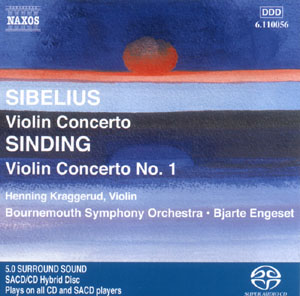 |
| SIBELIUS VIOLIN CONCERTO SINDING
VIOLIN CONCERTO NO. 1
HENNING KRAGGERUD, VIOLIN
BOURNEMOUTH SYMPHONY ORCHESTRA, BJARTE ENGESET
NAXOS SACD/CD HYBRID 6.110056 AND DVD-A 5.110056
|
|
0 |
5 |
|
Performance |
 |
|
Sonics |
 |
|
The world's best-selling classical record label, which for quite some time
threw its weight behind DVD-Audio by occasionally issuing recordings in both
redbook CD and DVD-Audio format, has now also embraced SACD hybrid
technology (discs playable on both SACD and conventional players) and
released its new recording of the Sibelius Violin Concerto in both DVD-A and
SACD formats. The DVD-A offers 5.1 Dolby Digital AC-3 and DTS Surround,
while the SACD (recorded with the DSD process) offers options of two-channel
CD and SACD as well as 5.0 SACD Surround.
For those like myself who continue to enjoy two-channel stereo, the good
news is that this is a wonderfully performed and recorded version of the
Sibelius. The soloist, Norwegian violinist Henning Kraggerud, is a winner of
Norway's Grieg Prize. Playing the Guarneri del Gesù “Ole Bull” violin of
1744 with its only existing extra-long violin bow, he produces unfailingly
lovely tone. The low tones, while perhaps not as meaty as those generated by
the Stradivarius Maxim Vengerov plays on his competing recording of the
concerto, are rich and full, while the highs are pure and sweet.
Emphasizing the lyrical aspects of Sibelius' concerto, Kraggerud eschews
excessive vibrato and big dramatic gestures to focus on the so-called
“dark,” brooding beauty of Sibelius' melodically lush landscape. With his
highest goal that of serving the music, Kraggerud's plaintive performance
draws less attention to technical perfection and effect than to the
extraordinary beauty of the writing. The opening is gorgeous, Kraggerud's
heart-touching phrases supported by the resonant entry of truthfully
recorded trumpets, cellos and percussion.
The playing in middle movement adagio again seems intentionally restrained,
the soloist avoiding showy, singing highs in order to emphasize the forlorn
beauty of the writing. After letting loose in the movement's grandly
romantic conclusion, Kraggerud performs the final allegro at a notably fast
pace. (If you don't know this concerto, the opening melody of the final
movement is unforgettable). Everywhere the Bournemouth Symphony Orchestra
proves at one with the soloist, providing full accompaniment with
unfailingly lovely tone.
By contrast, Vengerov's Telarc recording with Daniel Barenboim and the
Chicago Symphony Orchestra may be far more detailed, but the technique
constantly draws attention to itself. Sibelius' concerto becomes a series of
grand flourishes, with startlingly dramatic bites into the strings,
exclamation points at the end of soaring phrases, and an overall approach
that seems far more suited to Russian drama than Nordic romance. Barenboim's
equally overblown approach to orchestral interludes would serve Wagner well.
The other works on Kraggerud's program provide nice counterpoint. Sibelius'
Serenade in G minor, Op. 69b: Lento assai and Christian Sinding's Romance in
D major, Op. 100 offer many moments of loveliness. Sindings' First Violin
Concerto is far more Germanic sounding than Scandinavian; hardly in the same
league as the Sibelius, it's definitely pleasant listening fare. Meatier
companions would have been welcome, but Naxos' bargain price leads to a
strong recommendation. That the performances have been issued in the new
high-resolution hybrid SACD and DVD-Audio surround sound formats is a
definite plus. On highly affordable entry-level multi-format players, this
disc sounds light years better than standard CD.

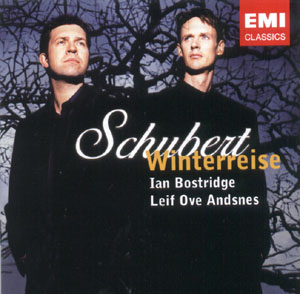 |
THE CHILL OF SCHUBERT'S FINAL WINTER
JOURNEY
FRANZ SCHUBERT: DIE WINTERREISE
IAN BOSTRIDGE & LEIF OVE ANDSNES
EMI CLASSICS 7243 5 57790 2
|
|
0 |
5 |
|
Performance |
 |
|
Sonics |
 |
|
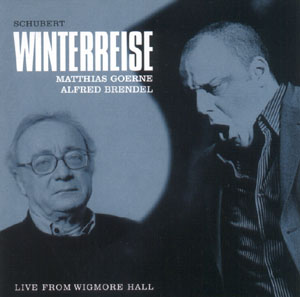 |
| FRANZ SCHUBERT: DIE WINTERREISE
MATTHIAS GOERNE & ALFRED BRENDEL
DECCA 027846 70922 1
|
|
0 |
5 |
|
Performance |
 |
|
Sonics |
 |
|
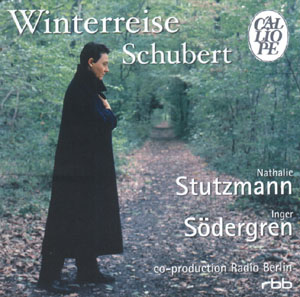 |
| FRANZ SCHUBERT: DIE WINTERREISE
NATHALIE STUTZMANN & INGER SÖDERGREN
CALLIOPE CAL 9339
|
|
0 |
5 |
|
Performance |
 |
|
Sonics |
 |
|
Franz Schubert survived only one winter between completing the first
version of his song cycle Die Winterreise (A Winter's Journey) and dying in
November 1828 at age 31. If the cycle's virtually unrelenting gloom and
despair mirror the realities of his slow and painful decline from the
syphilis he contracted as a teenager, its profundity has led to its
ascendancy as one of the great expressive vehicles for voice.
Schubert had already published his 1823 tenor song cycle Die schöne Müllerin
(The Lovely Maid of the Mill,) to poems by Wilhelm Müller when in early 1827
Franz von Schober drew his attention to a cycle of twelve additional poems
by Müller entitled Die Winterreise. Schubert immediately began setting them
to music, completing his work in February. It was only in autumn 1827, after
their publication, that Schubert discovered that Müller had subsequently
published an additional twelve Winterreise poems and issued all 24 in a
newly arranged sequence.
Schubert promptly began setting Müller's additional 12 poems, thereby
creating a cycle of 24 songs. He was still correcting proofs of the complete
edition on his deathbed.
Müller, who dedicated his Winterreise poems to composer Carl Maria von
Weber, had once stated that his poems led only a half-life “until music
infuses them with the breath of life.” Their discovery by his contemporary
Schubert thus served as an ultimate wish fulfillment. Sharing the composer's
karma, he too died young, in the autumn of 1827 at age 33, probably unaware
that Schubert had set his songs to music.
A number of contemporary accounts of Schubert's creation of Winterreise
survive. According to his friend Josef von Spaun, "For a time Schubert was in a melancholy mood and seemed to be rather ill.
When I asked him what the matter was he simply replied, ‘Well, you will soon
hear and understand it is all about'.”
Soon thereafter, Schubert invited von Spaun to Schober's house to hear the
“frightful” songs that “have made me suffer more than my other songs. He
then sang to us in a trembling voice the whole Winterreise. We were
completely taken aback by the gloomy mood of these songs, and Schober said
he had liked only one song, ‘Der Lindenbaum'.”
The history of contemporary Winterreise performance is so closely associated
with a legacy of baritone recordings that extends from Gerhard Husch through
Hans Hotter, Dietrich Fischer-Dieskau, and Matthias Goerne (with the
addition of an incomparable version from soprano Lotte Lehmann) that it is
easy to overlook that the cycle was originally set for tenor. The actual
range designation seems not to have been crucial in Schubert's mind. He had
downwardly transposed three of Winterreise's songs for either baritone or
contralto at the time of his death, and had previously dedicated his tenor
cycle Die schöne Müllerin to baritone Baron von Schönstein. What Schubert
considered primary was the energy singer and pianist brought to his songs.
Performing the cycle is no easy task. Besides the vitality and focus
necessary to sustain a performance that can last over 80 minutes, the
ability to imbue Schubert's frequent strophic repetitions with interest
demands artistic integrity of the highest order. You can alter tone and
dynamics in thousands of different ways, or vary tempo until hell freezes
over, but if your performance does not transcend technique to transport the
listener to a state of universal identification with the protagonist's
plight, the interpretation falls short.
Tenor Ian Bostridge and pianist Leif Ove Andsnes (EMI) have just recorded
the songs, paving the way for European and U.S. performances. Their
recording adds to a discography that includes tenors Peter Schreier, Jon
Vickers, Bostridge's fellow Englishman Peter Pears, and most recently
Christoph Prégardien. If the 1963 pairing of Pears and his life-companion
Benjamin Britten (Decca) continues to reign supreme, perhaps illuminated by
an inner identification with the suffering Schubert had no choice but to
voice in heterosexual terms, the modern version from Bostridge and Leif Ove
Andsnes offers far more beautiful sounds.
Having said that, I confess that Bostridge and Andsnes leave me cold, and
not in the way Schubert intended. Certainly Bostridge possesses a most
beautiful voice. Guided by great intelligence, his instrument retains the
freshness and ease of youth. When, as in the last verse of the first song,
he intentionally and sparingly softens his instrument to emit caressingly
sweet sounds, his singing possesses a pathetic fragility that goes straight
to the heart.
Elsewhere, however, the tendency to underscore words with pregnant emphasis
seems more precious than genuine. Especially when the tenor veers over the
top with emotion, bespoiling songs such as “Der greise Kopf” (The hoary
head) with a near hysteria that seems far more appropriate for Salomé than
Schubert, I find myself parting company. With his “listen to how important
this word is” approach continuing through the final, deathlike song,
Bostridge seems guided more by his thoughts about Schubert's music than an
emotional identification with it.
No one knows exactly what tempos Schubert wished for the songs, nor how much
freedom his chosen singers took with rests and phrasing. Bostridge and
Andsnes play it safe, offering a “modern” interpretation. Tempi are pretty
even, save for the occasional and welcome ritard. The freedom we hear in
older lieder recordings is rarely in evidence. Where Britten's genius
consistently illuminates Schubert's piano line, underscoring phrases that
either answer the singer or set the primary tone, Andsnes chooses to contain
himself, a wise move considering Bostridge's over-emoting. There is some
beautiful bell-like tone in “Die Krähe” (The Crow), but for the most part,
this is Bostridge's show, with Andsnes providing sober balance.
For contemporary interpretations, I find myself turning to two other new
recordings. The first, capturing Matthias Goerne and Alfred Brendel live at
Wigmore Hall (Decca), has already received much critical acclaim. To these
ears, their interpretation is far more nuanced than Goerne's recent
extraordinary live San Francisco performance of Winterreise with Eric
Schneider. The voice is gorgeous beyond belief, moving between profound
baritone rumbles of despair and higher, melting tones. More important, the
singing and playing seem to spring from a genuine sympathy with the work.
This collaboration constantly reaches inward to the core pulse of despair.
Equally essential, moreso for receiving little attention is contralto
Nathalie Stutzmann's shattering performance with pianist Inger Södergren.
Hearing Stutzmann's rich, soulful voice convey the essence of Schubert's
suffering makes one mourn that the fallout from 9/11 prevented her from
flying to San Francisco in 2002 to record Mahler's Kindertotenlieder with
Michael Tilson Thomas.
Stutzmann's recent Vivaldi performance in Berkeley revealed her wearing a
tasteful, iridescent gray pantsuit set off by high-soled, lace-up patent
leather shoes so emphatically masculine that I can imagine Gertrude Stein
trading of one of Alice B. Toklas' precious recipes for a pair. Stutzmann's
heart-rending timbre and uncommon freedom with nuance and tempo make the
recording one to treasure. Some of the songs are taken so slowly that only a
great artist with unfailing concentration – a gift Goerne shares -- could
render them so riveting. The voice does occasionally approach shrillness in
more emphatic passages, but the overall beauty of the interpretation,
constantly infused with heart-touching tones of suffering, makes this a
performance to own.

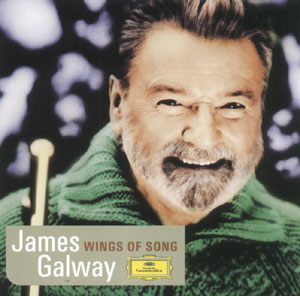 |
| JAMES GALWAY: WINGS OF SONG JAMES
GALWAY, FLUTE AND TIN WHISTLE; JEANNE GALWAY, FLUTE, MORAY WALSH,
CELLO SOLO
LONDON SYMPHONY ORCHSTRA, KLAUSPETER SEIBEL
DG B0003024-02
|
|
0 |
5 |
|
Performance |
 |
|
Sonics |
 |
|
Sir James Galway's latest release augments a huge discography that fully
documents the 65-year old flautist at the height of his powers. If Wings of
Song: Popular Classical Melodies for Flute and Orchestra, his first disc for
Deutsches Grammophon since his old days performing as principal flute with
Herbert von Karajan and the Berlin Philharmonic does nothing to enhance his
reputation, it certainly attests to the across-the-board popularity he has
achieved.
Although Wings of Song undoubtedly takes its name from Felix Mendelssohn‘s
evocative song Auf Flugeln des gesanges (On Wings of Song), that selection
is curiously absent from the album. Instead, we have a mix of such soothing
classical stalwarts as Maurice Ravel's Pavane pur une Infante défunte, Eric
Satie's Gymnopédie No. 3, an adaptation of the 2nd movement of Joaquín
Rodrigo's “Concierto de Aranjuez,” the 1st movement Siciliano from J.S.
Bach's Sonata for Violin and Harpsichord No. 4 in C minor, and an
arrangement of the 2nd movement from Antonin Dvorák's String Quartet No. 12
in F major “American,” with a number of opera arias and classical art songs
thrown into the mix.
As the Voice of Woodstock whistling Puccini in the Emmy-nominated televised
Peanuts cartoon, She's a Good Skate, Charlie Brown, I hesitate to criticize
transcriptions of opera for instrument. Yet it must be acknowledged that
anyone hoping for the passion and exalted spirit associated with such arias
as Camille Saint-Saëns' “Mon coeur s'ouvre à ta voix,” Vincenzo Bellini's
“Casta diva,” Christoph Willibald Gluck's “Che faro senza Euridice?” and
Richard Wagner's “Der Engel” has another story coming.
The pearly, ultra-smooth sound of Galway's flute certainly conveys the
loveliness of these arias, but melodic sweetness is only one of the reasons
they are treasured. The other is because they serve as supreme vehicles for
the expressive powers of the human voice. If Galway's flute can achieve such
a level of expression – there are hints of passion in the Rodrigo excerpt –
it certainly falls short in opera. The tone may be beautiful, but the
performances are placid. Delilah could never seduce Samson with such
languor. To call the playing “pretty” pretty much says it all.
Where Galway does excel is in the duet with his wife Jeanne on Jacques
Offenbach's beloved Barcarolle -- music that perfectly suits the dreamy
tenor of their playing -- and Howard Shore's A Lord of the Rings Suite
written expressly for Galway's talents. Galway's rendition of John Denver's
“Annie's Song” also scores in spades, as do the more serene of the classical
instrumental adaptations. As for Craig Leon's soppy introduction to Franz
Schubert's “Ave Maria,” you don't want to know from it.

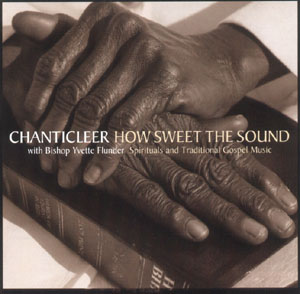 |
| CHANTICLEER: HOW SWEET THE SOUND
SPIRITUALS AND TRADITIONAL GOSPEL MUSIC WITH BISHOP YVETTE FLUNDER
WARNER CLASSICS R260309
|
|
0 |
5 |
|
Performance |
 |
|
Sonics |
 |
|
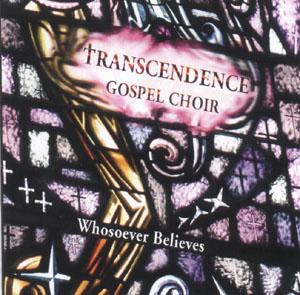 |
| TRANSCENDENCE GOSPEL CHOIR:
WHOSOEVER BELIEVES AMOR
|
|
0 |
5 |
|
Performance |
 |
|
Sonics |
 |
|
“God has no respect of persons” was a phrase I heard over and over in the
summer of 1965 as a civil rights worker in North Carolina's Martin County.
Almost 40 years later, when the Democratic National Convention's
representatives for the first time accurately reflected the rainbow
composition of our society, white people are daring to embrace music usually
performed by African-Americans. From German baritone Thomas Quasthoff's
recent awesome San Francisco Performances encore of “Old Man River” to
Chanticleer's new recording of spirituals and traditional gospel music, we
are discovering how music and diversity-embracing activism can transcend
racial division.
The all-male Chanticleer vocal ensemble is hardly all white. For much of its
existence it has benefited immeasurably from the multiple gifts of its
African-American music director Joseph Jennings. Jennings imparts an
authentic spirit to this disc, not least by arranging all the selections,
providing authentic-sounding upright piano accompaniment, and occasionally
offering his voice.
Equal blessing, if I may be so bold, comes from Bishop Yvette A. Flunder (aka
Rev. Dr. Yvette Flunder). From her beginnings singing in her grandfather's
San Francisco church, Flunder transitioned from a solo career to singing and
preaching internationally with the famed Hawkins Family Singers. In 1991 she
founded the City of Refuge Community Church and Ark of Refuge, Inc. in San
Francisco, training African-American church ministries in HIV/AIDS
prevention education and offering housing and support services to people
living with HIV/AIDS. Eight years later, she developed the “One Voice:
Gospel Artists Respond to AIDS” educational campaign and gospel concerts
with the Centers for Disease Control. As Bishop of Fellowship 2000, a group
of 54 churches, Bishop Flunder travels internationally, singing and
preaching a message of inclusivity for all peoples.
What all this talent translates into is an inspiring, musically perfect
disc. Despite frequent personnel changes, Chanticleer remains a crack
ensemble. Thanks to Jennings' direction, every note and word is perfect,
every harmony shining. One cannot help smile when Flunder sings “God” the
way most people in America pronounce it, while the white boys make the word
sound more profound by singing “Gawd,” but they've got the idiom down pat.
Even Philip Wilder's curiously fem soprano solo on “Keep Your Hands on the
Plow,” exclaimed in a voice that sounds more suited to quilt-making than
field work, in the end earns smiles rather than criticism. This is a disc to
banish cynicism.
It is impossible to overstate the brilliance of Joseph Jennings'
arrangements. A recent performance by the East Bay Gay Men's Chorus featured
an arrangement of “We Shall Overcome” that sounded not only repetitively
foursquare – the same off-beat movement between vocal lines in each verse –
but spoiled the sentiment of a civil rights anthem that for years left me in
tears by ending with an overly soppy reprise that seemed best suited to the
vocal equivalent of a Hallmark greeting card.
Jennings makes no such errors. His harmonies, phrasing, rhythms are
constantly alive and changing in ways that enhance rather than distract from
the spiritual message of the music. To cite just two examples out of
hundreds, the traditional “There is a Balm in Gilead” begins with the chorus
offering soft wordless background as Flunder starts her solo. Only when she
begins the recapitulation do the boys begin to sing the words, underscoring
her voice with a softness that sounds like balm indeed. In the subsequent
extended Poor Pilgrim Medley, long-time ensemble member soprano and recent
departee Christopher Fitzsche's very high solo is strikingly followed by
veteran Eric Alatorre's deep bass at the start of “Poor Pilgrim of Sorrow.”
Light and shade, highs and lows, all are judiciously contrasted in perfectly
paced performances filled with spirit.
Spirit and then some also abounds in the Transcendence Gospel Choir's
Whosoever Believes. Based in the Bay Area, the world's only transgender
gospel choir deservedly won the 2004 OutMusic Choral Award for their truly
inspiring disc. The so-so sound of the independent effort cannot compare
with Warner Classics' truthful, state-of-the-art sonics, but the spiritual
conviction is awesome.
The disc begins with Pastor Jonathan Thunderwood and Reverend Dr. Yvette
Flunder preaching a message that reclaims ALL people, regardless of color or
orientation or sexual transformation, as God's children. It's only up from
there, as arrangements by disc producer and alto Ashley Moore and others
find the chorus in inspired form. I don't know how many members of
Chanticleer actually practice Christianity, but it's clear these folks sing
as if their lives depended on it. Perhaps atheists, Martians, those
historically oppressed by Christianity or recovering from church
indoctrination and abuse will go “so what,” but the rest of us will likely
find ourselves on our feet, clapping our hands in praise of a spirit that
ultimately transcends Christianity. The small, one-of-a-kind Transcendence
Gospel Choir (www.tgchoir.org) has created an instant classic, one that
deserves the widest possible audience.

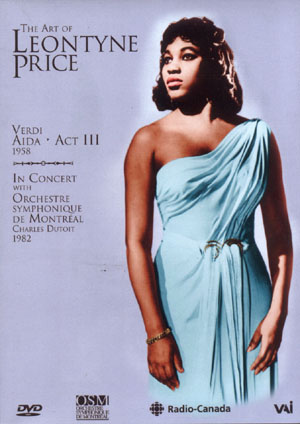 |
| THE ART OF LEONTYNE PRICE:
RADIO-CANADA TELECASTS, 1958-1982 VAI DVD-VIDEO 4268
|
|
0 |
5 |
|
Performance |
 |
|
Sonics |
 |
|
This historic footage displays the glorious soprano Leontyne Price during
her initial rise to stardom. Complemented by an entire concert performed
live on October 3, 1982 at age 55, less than three years before her
retirement from the operatic stage, the program allows us to assess the
gifts of one of the pre-eminent lirico-spintos of the last fifty years.
Price first assayed her signature role of Aida in 1957, one year before
singing the entire Act III of Aida for this Canadian film. While she had
already toured the U.S. in a production of Porgy and Bess, performed Samuel
Barber's Hermit Songs with the composer at the Smithsonian, appeared in
NBC-TV's 1955 staging of Tosca, sung music by Lou Harrison in Rome, and
created Madame Lindoine in Poulenc's Dialogues of the Carmelites in San
Francisco, audiences were still accustoming themselves to the notion of a
“Negro” cast as a lead opposite whites. Playing Aida, an Ethiopian slave who
falls in love with an Egyptian general, was thus not only an “acceptable”
role for her, but one with which she deeply identified. In few other roles
did Price find a vehicle so perfectly matched to her vocal strengths and
emotional sympathies.
Act III of Aida, staged by Irving Guttman and telecast in black and white on
October 23, 1958, also features Willliam McGrath as Radamès and Napoléon
Bison as Amonasro. Jacques Beaudry conducts L'Orchestre de Radio-Canada. Not
only do we hear her voice in first flowering, but we also see Price act at
age 31, when she was still young, lithe, relatively slender, and less prone
to posturing herself as a goddess. She comes off quite well, exhibiting a
fair amount of dramatic involvement while singing like an angel.
Early in her career, Price's voice was glorious and even throughout the
registers, with those uniquely sensual, thrilling highs of hers spun out
with mesmerizing freedom. Never known for perfect phrasing, she here
exhibits an ease of production, mastery of legato, and technical surety not
always present in later years. While 1982 finds her practicing full out can
belto, in 1958 she allows herself to sing entire phrases softly. She also
exhibits a freedom of tempo and other subtleties often sacrificed for the
sake of being heard at the far end of the hall. The other principals are far
more workaday, with McGrath visually implausible as a war hero. But Price is
truly a soprano to die for.
The 1982 concert, shot in color with Charles Dutoit conducting L'Orchestra
symphonique de Montréal, finds her in drier voice. The opening “Come scoglio”
and “Ernani, involami!” are rough going, Price squeaking out the highest
notes on more than one occasion. The passagio between chest and middle voice
has grown troublesome, with words sometimes half sung/half spoken (even
shouted) to get through the break. But the voice warms up as the concert
continues. Verdi's “Pace, pace mio Dio!” from La Forza Del Destino offers
some breathtakingly beautiful phrases and sounds in the upper middle
register, as well as a thrilling climax. If the voice and temperament are by
this time much too heavy for Puccini's “O mio babbino caro,” Tosca's rapidly
sung “Vissi d'arte” offers tear-inducing beauty.
All important bonus material comes in the form of four snippets from the
Bell Telephone Hour. Leonora's two great arias from Verdi's Il Trovatore
come from 1963, just two years after Price's Met début in the role inspired
one of the longest standing ovations in the house's history. Subtlety of
phrasing learned from Herbert von Karajan remains intact, with the ending of
“D'amor sull'ali rosée to die for. 1966 brings Aida's Ritorna vincitor!,
with Price looking far more beautiful if sounding a shade less inspired than
in 1958. Finally, 1967 gives us a superb “Pace, pace mio Dio,” with the
soprano framed by billowing lavender gauze one month before she hit 40.

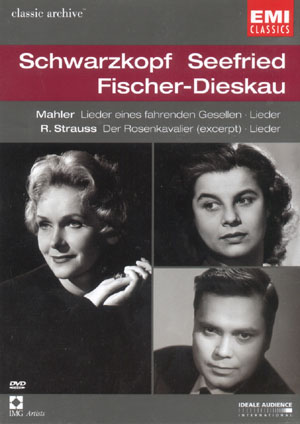 |
| SCHWARZKOPF SEEFRIED
FISCHER-DIESKAU
EMI CLASSICS DVD 7243 4 90442 9 6
|
|
0 |
5 |
|
Performance |
 |
|
Sonics |
 |
|
This priceless DVD, issued in conjunction with the BBC, offers three of
the greatest singers of the lp era performing the repertoire by Strauss,
Mahler, and Schubert for which they were most prized. Viewing is a necessity
because of the first selection on the program, the Finale from Act One of
Richard Strauss' Der Rosenkavalier filmed in London in 1961 with soprano
Elisabeth Schwarzkopf as the Marschallin, mezzo-soprano Hertha Töpper
playing Octavian, and Charles Mackerras conducting the Philharmonia
Orchestra.
Volumes have been written about Schwarzkopf's Marschallin, and for good
reason. Lotte Lehmann, Regine Crespin, and Kiri Te Kanawa all left memorable
interpretations, but only Schwarzkopf's is so vivid and alive to the moment
that she literally seems to transcend Strauss' score and become the
Marschallin.
Schwarzkopf's Marschallin is most remembered from the film and recording of
the famed 1957 production that paired her with Christa Ludwig, Theresa
Stitch-Randall, Otto Edelmann, and conductor Herbert von Karajan. Yet the
soprano has stated on at least one occasion that her interpretation grew in
the years that followed that performance. This footage allows us to see the
difference that four years made.
Though Schwarzkopf was by this time approximately 46 years old, her beauty
and voice had if anything ripened rather than declined. She had also honed
to perfection the Marschallin's every physical and vocal gesture. While her
painstakingly analytical approach to music frequently resulted in
overstated, self-consciously exaggerated lieder performances, it proves
entirely appropriate for the Marschallin's utterly self-conscious
self-critical monologue.
In Schwarzkopf's Marschallin, art and artifice unite as one. Save for two
brief moments when the phrasing seems overdone, her identification with the
character seems utterly natural. Only soprano Magda Olivero's verismo
interpretations from the same period achieve Schwarzkopf's level of
veracity. Hertha Töpper may be a vocally non-ingratiating Octavian, but her
square-jawed countenance adds a touch of credibility to the pants role.
Next on the program, soprano Irmgard Seefried, one of Schwarzkopf's greatest
rivals in lieder interpretation, sings five lied by Strauss in Salle Pleyel,
Paris in 1965 and three songs by Mahler at the ORTF, Paris in 1967. Although
she was known for her simple purity of voice and interpretation, Seefried
seems either past her prime or in less than ideal voice or both. With no
help from frequently distorted sound, the footage fails to satisfy.
The DVD ends with two major contributions from Dietrich Fischer-Dieskau.
Blessed with a gorgeous voice, the baritone shared with Schwarzkopf the
tendency to concentrate on the minutia of lieder interpretation. Happily,
these performances are from a less mannered period early in his career, when
he was also in most beautiful voice. Mahler's Lieder eines fahrenden
Gesellen (Songs of a Wayfarer), with the NHK Symphony Orchestra under Paul
Kletzki, comes from Salle Pleyel in 1960, followed by four Schubert lieder
accompanied by Gerald Moore in London in 1959. The value here is in the
singing rather than the visuals.

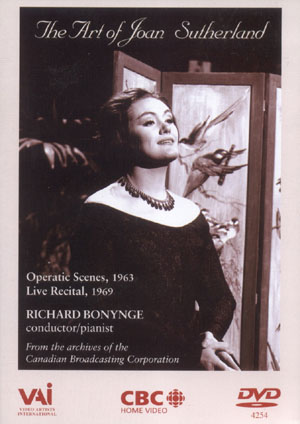 |
| THE ART OF JOAN SUTHERLAND RICHARD BONYNGE, CONDUCTOR/PIANIST
VAI 4254
|
|
0 |
5 |
|
Performance |
 |
|
Sonics |
 |
|
From the archives of the Canadian Broadcast Corporation come two previously
unreleased programs featuring coloratura soprano Joan Sutherland (not yet
Dame Joan) expertly supported by her husband Richard Bonynge. The first,
filmed in black & white in 1963 expressly for the CBC, intersperses
Sutherland's stilted, formal spoken introductions to the lives of great
coloraturas of the past (complete with deadening stills of portraits and
interminable panning of walls) with brilliant performances of arias either
written for or closely associated with those sopranos. Accompanied by the
CBC Orchestra conducted by Bonynge, and joined in duet by slight-voiced
tenor Richard Conrad (who also contributes a solo from Donizetti's Don
Pasquale). Sutherland sings two arias from Bellini's I Puritani, “Bel raggio”
from Rossini's Semiramide, coloratura displays by Benedict and Ricci, and
Violetta's first act scena from Verdi's La Traviata. The upper range is
brilliant, the coloratura leaps, trills, and runs stunning. Though she was
hardly an insightful interpreter, Sutherland as technically astounding
vocalist was at this point in her career beyond compare.
From six years later, Sutherland presents a live, performed-for-television
recital filmed before an initially enthusiastic audience. With Bonynge
playing the piano wonderfully while maintaining an absolutely unmoving
visage in order to maintain all focus on his prima donna, Sutherland mainly
performs works that lie lower in her range. Only occasionally displaying her
brilliant top and coloratura mastery, she delivers mostly dreary renditions
of works by Gretchaninoff, Rossini, Bellini, Gounod, Bizet, Massenet,
Delibes, Bononcini, Handel, and Alabiev. Poor enunciation, unvaried tone and
lack of emotional expression do not great singing make.
The most interest comes when she fluffs the opening line of one selection,
leans over the piano toward Bonynge and begins cursing her gown off. She
catches herself in the middle of “shhhhh…” After getting a good laugh out
and regaining her composure, she starts over, this time with every note
perfectly in place. Even Balfe's “I dreamt I Dwelt in Marble Halls,” a piece
dear to her heart learned from her mother, proves prosaic. But the
coloratura from 1963, and the opportunity to see La Stupenda briefly let her
hair down are to treasure.
- Jason Victor Serinus
-
Terms and Conditions of Use

|